New Age Group Categories
Remember this announcement a couple months ago?
It seemed like everyone in the OCR community made a big deal about Spartan Race getting rid of the Competitive category and switching it with Age Groups. Most of the complaints came from those in the 45+ portion of the 40-49 age group, as they argued even just a 5-year age difference makes a huge difference for Master’s athletes. This topic blew up on social media, with most of the arguments favoring the older racers. Many said that Spartan should combine 18-24 with 25-29 and create a single 18-29 age group. Instead of one 40-49 age group, many wanted to separate 40-44 from 45-49, too. Despite lots of negative feedback, Spartan decided to stick with their initial 6 age groups.
First Spartan Race of 2018
Let's fast forward to this past weekend when Spartan Race hosted its first US race of 2018 in SoCal. Would participation numbers for Master's athletes be higher than those in their early 20s? Short answer: yes.
There were nearly as many 45-49 male racers (58) in the Saturday Super as there were 25-29 male racers (63). In fact, there were more 45-49 male racers in the Sunday Sprint than there were 25-29 male racers. On both Saturday and Sunday, nearly 1/3 of all male racers were from the 40-49 division, while approximately 1/6 of the total males were from the 18-29 combined age groups. For females, participation numbers in these age groups were relatively similar. Of course, this is just one weekend of racing, so more results need to be analyzed to have more confidence in the data.
Participation Numbers
Does it even make business sense for Spartan to have separate 40-44 vs. 45-49 age groups, though? After all, Spartan would lose money if they don’t have enough participation in these age groups. One race from this past weekend is too small a sample size to make any conclusions, so I looked at overall participation numbers over the past three years from a few races. Each race was from a different area of the country and for each distance type in order to get some variety in my sample. As you can see, there were typically nearly twice as many 40-49 racers as there were 18-24 racers (which gets its own age group category).
I took it one step further and broke down the 40-49 age group into the two desired age groups: 40-44 and 45-49. Those charts sure look pretty identical for each venue, don’t they?
The 40-44 age group almost always had a higher number of racers than the 18-24 age group. Similarly, participation numbers for the 45-49 age group were within 1-2% of those from the 18-24 age group. This suggests that there will be sufficient participation from the 45-49 age group to warrant their own division. Despite what the data shows, let’s say Spartan Race decided that they won’t create a 7th age group to separate 40-44 and 45-49. If Spartan is determined to have exactly 6 total age groups, are they choosing the right ones?
Peak Athletic Ability
There’s a reason high school sports have the freshman, JV, and varsity teams. Most human bodies undergo major transformations during your high school years, which is why so few high school-aged athletes can make a major impact on a college team. Most high school-aged racers would fall into Spartan’s 14-17 age group, which I agree is a fair age group range. Athletes tend to get stronger and faster as their bodies rapidly grow during puberty. You continue to develop physically for a few years before reaching your “physical peak” sometime in your 20s. Even the most well-trained athletes can only stay within their true physical peak for about a decade before their performances inevitably drop.
Despite having more experience and awareness, older players are constantly replaced by unproven younger players. Why do you think so many people make a big deal about Tom Brady playing at such an elite level despite being 40 years old? Because it’s so rare! In fact, there have only been 60 players in the entire history of the NFL who played during their age-40 season, and nearly half of those have been kickers. In the 100-year history of the NHL, there have only been 85 players to play into their 40s, and that number shrinks to 27 if you look at the NBA.
Carry this over to OCR and you’ll notice a similar trend. Yes, there are outliers like Hobie Call and Cody Moat who continue to dominate opponents 10+ years younger than them, but in general, athletic performance declines noticeably once you reach your late 30s. Very few Master’s athletes remain competitive with the best-of-the-best racers, and those who do are in their early 40s, not their late 40s.
Age Grading
Most people think of obstacle course races as jumping over walls, weighted carries, doing monkey bars, etc. In reality, completing all of these obstacles combined will take up less than 20% of your total race time. At least 80% of your time on the course will be spent running, so it’s worthwhile to compare OCR performance to running performance at various ages.
Older runners can actually remain competitive with the top elite runners late into their 30s in longer distance events since it takes over a decade to maximize your aerobic capacity. The opposite is true for shorter events, though, so if you want to set a PR in the 100m, you probably want to do it before you’re 33.
Age grading is used by track and field to take into account the natural decrease in athletic ability as we age. Everything is on a “0-1” scale, where “1” means you’re in your physical prime (typically in your 20s for both genders) and anything lower means your age suggests that you are no longer in your physical prime for that distance. Here’s a great explanation on age grading, along with a calculator (at the bottom), so you can plug in some numbers and see how some of your recent running times rank.
For those of you who are data nerds (like me), there's a link to an Excel file on this page with every single age grade factor for dozens of running distances. Rather than forcing you to scroll through thousands of lines of Excel data (exciting, I know), I made this chart to show how age grades change over time, specifically from ages 18-49 since those are the age groups that most are complaining about:
Say you’re a 25-year old male (age grade = 1.000) who runs a 5k in 18:00. The equivalent performance by a 40-year old male (age grade = 0.945) would be a 19:02, while a 49-year old male (age grade = 0.882) would need to run a 20:24. In order to run equivalent performances at different ages, you’d run over 25 seconds slower per mile in a 5k just by aging 9 years between 40-49. That’s a huge drop in pace for “equivalent” performances. Clearly, a 49-year old athlete is not the same athlete as a 40-year old was, so why did Spartan put them in the same category?
Now let’s take a look at the average performance increase/decrease compared to your ability 5 years earlier (based on age grading). As shown in the chart, a 49-year old female can expect to be 4.7% slower than she was as at 45 and 8.6% slower than she was at 40. Similarly, most 49-year old men are at least 3.2% slower than they were at 45 and 6.3% slower than they were at 40. This cumulative trend becomes even more dramatic once you reach your 50s (for both genders).
Conclusions
Athletic performance levels stay very consistent throughout your 20s. In fact, there is very little difference in athletic ability from ages 18-34. Once you reach your mid-30s, however, athletic performance slowly drops until major decreases begin your 40s. Ask anyone in their 40s and they’ll tell you that they just don’t recover like they used to even a few years ago.
Unfortunately for the 50+ racers, participation numbers don’t appear to be high enough to justify smaller 50+ divisions, such as 50-59, 60-69, etc. Peak athleticism decreases even more sharply into your 50s and 60s, making it even more difficult for racers approaching retirement to end up on the new 50+ Age Group podium. Unless a massive wave of passionate 60+ racers starts participating in OCR events, it doesn’t make financial sense for Spartan to make changes to their 50+ category.
Keep in mind that everyone gets one year older each year, and many of the current 40-44 racers will soon fall into that 45-49 category. Finding new customers is one of the hardest things to do in business, so it would be a poor move for Spartan to anger many of its existing customer bases. Several financial studies have shown that your peak earning years occur in your late 40s, which suggests this is when your disposable income would be highest. In other words, you’re probably more likely to spend extra money at the event (which makes race companies happy).
Bottom line, Spartan Race is absolutely doing the right thing by adding age group divisions to replace to former Competitive and Master's divisions. Establishing proper age group divisions adds legitimacy to competitive obstacle course racing and will bring with it a lot of excitement and new names to watch in 2018. However, the data shows that Spartan Race should reconsider their new age groups. If Spartan Race wants to stick with only 6 age group divisions, they should get rid of the 18-24 category and combine it to create an 18-29 division.
Creating separate 40-44 and 45-49 divisions is absolutely justified.
Will Spartan Race make the right decision?
Disclaimer: The viewpoints expressed by the authors do not necessarily reflect the opinions, viewpoints and official policies of Mud Run Guide LLC, or their staff. The comments posted on this Website are solely the opinions of the posters.

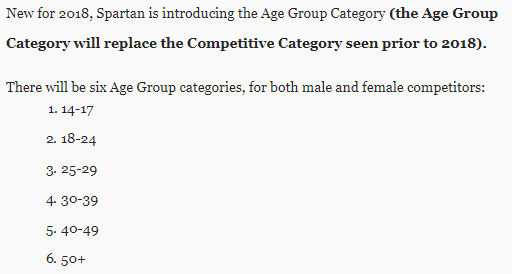
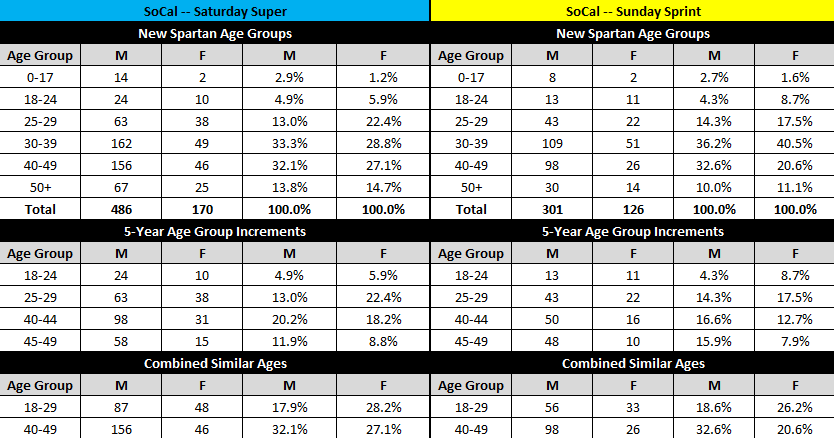
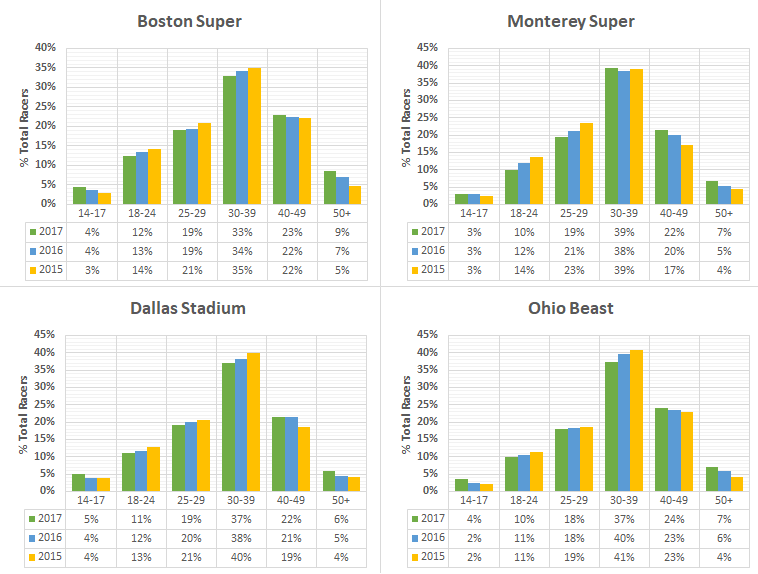
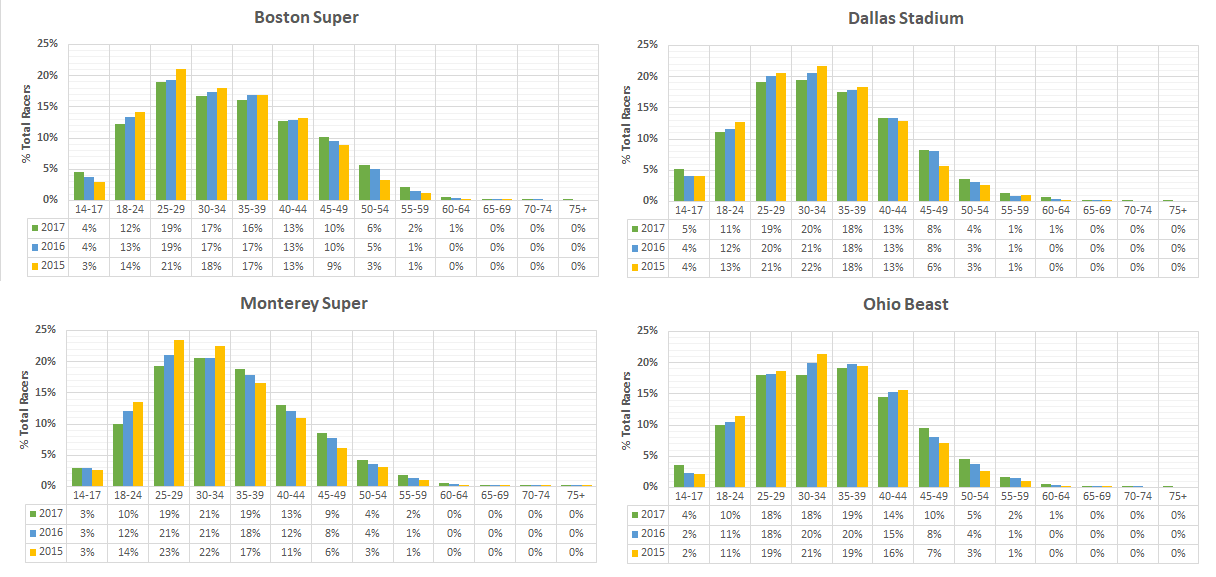
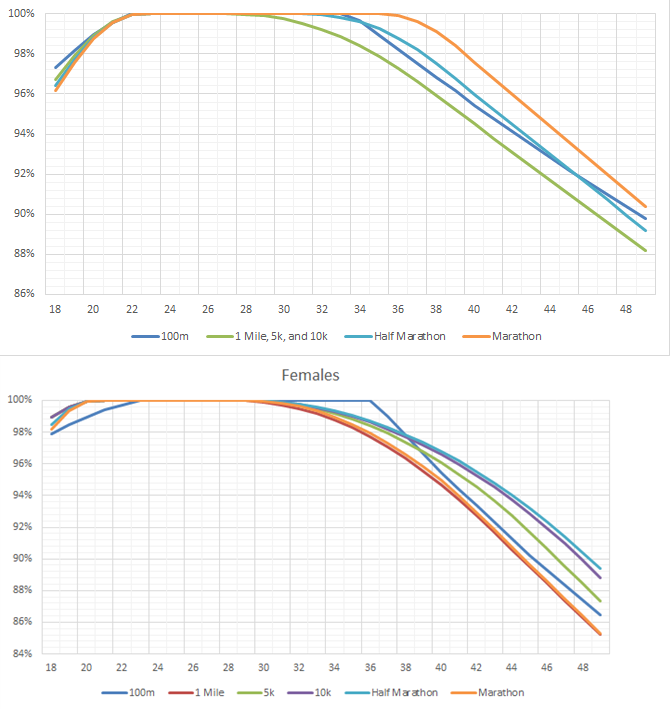
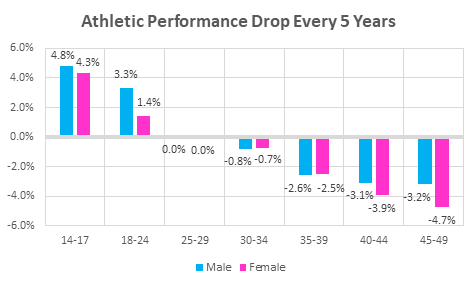


45-49 would be justified
Age group heats is a bad idea, Spartan will never police all of the obstacles and burpee penalties the way they should be ,not to mention running thru extra traffic results will never be on equal playing field . Especially for 300+ elites and then 600+ age group runners. I believe the best answer for this problem is to just have elite heat with age group awards every 5 years, and concentrate on all obstacles and burpee penalties in a strict professional manner. If they want this sport to be taking serious. I am sure they will not do this because think of the extra money they get for extra age group heat runners. Some people pay extra just for earlier heat.
This is excellent and provides data for what I’ve been feeling the past couple of years. At age 48, I see radical performance changes from as little as 2 years ago. (Actually seeing these data makes me feel better as I thought there was something really wrong with me but now I see that the dropoff in performance is normal).
I definitely agree that Spartan should split the 40s category into 40-44 and 45-49. We are a large demographic with more disposable income than a lot of the other age groups, plus we bring our children (and yes, we’re the ones paying their race entry fees), many of whom are in the under 17 and 18-24 categories.
Spartan, please pay attention to Mr. Bauer’s article.
Excellent analysis, but I must say that I am a little bummed being a 58 year old OCR fanatic in all of this. The difference between a typical 50 year old and a 59 year old I’m sure is typically quite large also. I believe I may be what you would call an “outlier” in that I have been placing mostly 1st in my age group in all of my races, with my best being 1st out of all 50+ entrants over both Saturday and Sunday at Fenway this past year. We shall see how this shakes out with the east coast races starting in April and beyond this year, but I understand the business decisions behind it all with the participation numbers for the different age groups. Thank you.
Awesome writing and research Jack ?
Great and very comprehensive article. I agree 100%. Of course, I’m in that 45-49 age group, but my own personal gripes aside, it just makes good business sense. As you can see from the numbers, that 40-49 age group is just too big! Having all those people in the start corral and leaving the line at the same time is just ridiculous. Even if they split that into 40-44 and 45-49 age groups, both of those would be among the biggest groups of the competition. As someone who worked hard the last couple of years to make it up the ranks of the 45-49 Competitive division, it’s really a letdown to now have to compete, both against guys coming down from Masters Elite, and those who are almost ten years younger than I am! I was looking forward to the competitive nature of the new Age Group category, but, as it stands right now, there’s almost no chance for guys like me to even come CLOSE to a podium finish. If Spartan thinks this is the way to get guys in my age group excited about racing, they’re sadly mistaken. I certainly hope they won’t wait till the end of the season to make things right.
I am in agree ment with Mark. There are plenty of 50+ athletes that take racing seriously. I don’t see how having 5 yr increments across the board would be a problem…..there are no cash prizes for age groups…or at least shouldn’t be. And, if you combine a few groups that have less registrants for particular race, the total number of heats wouldn’t have to increase. I don’t see how this would be a major cost to Spartan, but certainly would make their competitors happier.
As far as policing burpees etc and limiting people in the AG heats with associated congestion, I would not be opposed to an even greater price premium to help ‘dissuade people who only sign up for it (or elite heat) bc of the earlier start times.
(Could also consider some basic level performance on a regular season race in order to register for AG at regional and national races…like it is for worlds)
As far as policing the AG heats goes, it would not be hard or cost prohibitive to video obstacles and verify only podium finishers as to completion of obstacles/burpees. Racers have timing chips to allow rapid veiwing of their obstacles for review.
I completely under 49 year olds not wanting to race against 40 year olds. Wait till they are older, I’m 66 and have to compete against 50 year olds. Spartan needs a 60+ AG.
Within the top 10 of the 40-49 (and even the 30-39) group, what we’re the actual ages? How does the 40-44 group actually compare to the 45-49? Was the top 10 all racers below 45 years old?
This is a well written article with great data to support the arguments made about changing the masters age group divisions into two separate age groups and combinding younger age groups 18-29. It all makes sense performance wise and financially so hopfully, Spartan Race will take it into consideration. Afterall, it is a business at the end of the day right?
Great read Jack! Greetings from Germany.
Great article Jack! I’m 55 and have been running OCR for the last 18 months. There’s no doubt OCR racing is both physically and mentally demanding. It’s great and I love it! I believe there should be 5 year age groups up to 70 years old. I want to be able to compare my times to my own age group as well as the younger runners. It may be a somewhat selfish motive, but I think a lot of senior runners feel the same way. Good health and much continued success to OCR athletes everywhere on their 2018 season!
I think the best thing Spartan could have done was keep the masters elite and add a grandmasters elite, the competitive racers don’t want to get bottled up, I’m going from running elite masters starting with the top guys and always coming in top 20 overall with a chance to podium in masters to starting after half the age groups , no way ill make it through all those people without losing a ton of time Grand Masters division would have solved everything!
Ive competed in many races. I’m 60 years old am in excellent shape. I recently competed in a Spartan Sprint in Vermont. 4 Miles my time was 2 hr 6 min. I compete with all age groups. I placed 41 st out of 114 in my heat. I understand why there is no age 60 to 69 because some individuals our age are unable to compete. It would be simple just to add another age group to give us 60 and over incentive to compete. I’m not interested in winning 1st 2nd or 3rd place just give us a chance to run against individuals our own age.
I agree with many above that it is a disappointment that there is only one age category for participants 50 and older. I am deep into my 60’s and competing with individuals almost 20 years younger. I think it would be great (and more fair) to compete against those closer to my age, at least within the same decade. I would gladly pay more for this option. Much thanks and success!
Tom Teeter ( Dirty Deeds)
Well I am 70 and finish in the top 40% or better , I finished 2 Trifectas, and 12 trail races in 2019. I may be a freak for training 2 rs per days 6 days a week , Age group should be 70 and up. LIke most trail races. I understand it’s just that Spartan does not want GEEZERS showing up unless it’s to VOLUNTEER , and I did 6 Volunteer shifts in 2019.